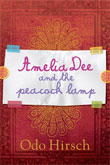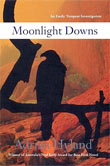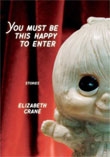She dazzles us with lyricism, with meter and cadence as well as story. That should not surprise: Anne Simpson

, the novelist, came after Anne Simpson, the poet, at least for the purposes of her bibliography.
Simpson’s first published collection, 2000’s
Light Falls Through You, was the winner of the Gerald Lampert Award and the Atlantic Poetry Prize. Her debut novel came the following year:
Canterbury Beach (Viking Canada) was published to much applause in 2001.
Simpson’s most recent book is called
Falling (McLelland & Steward) and it shows early signs of outstripping even that first novel’s acclaim.
“Simpson’s skill is such that the sum total here is far greater than the parts,” said Emily Donaldson for
The Toronto Star. “We don’t quite realize the force of what’s built up until near the end, when we suddenly find ourselves fully invested in this compelling web of characters.”
Here’s hoping that she gets the chance to see her Luna moth, after all.
 A Snapshot of Anne Simpson…
A Snapshot of Anne Simpson…Born: Canada
Resides: Antigonish, Nova Scotia
Please tell us about your most recent book.This novel really had its beginnings, in an article that I think I read in
Saturday Night Magazine -- this was five or six years ago -- about someone who was obsessed with designing barrels meant to go over Niagara Falls. I asked myself the question: why would anyone be obsessed with doing that? Why would anyone go over the Falls? And the more I thought about it, the more I became interested.
I guess I’d say that
Falling is a novel about how ordinary people rise to meet enormous challenges in their lives. I was especially interested in two characters: Damian, who is in his early 20s, and his mother, Ingrid. I wondered whether they would move towards creativity or towards destruction. And I think they move towards creativity, ultimately.
What’s on your nightstand?If Not, Winter: Fragments of Sappho, a book of Sappho’s poem fragments translated by Anne Carson. And
Scar Tissue by Charles Wright. I also have a couple of books in the pile from Gaspereau Press, a really fine small press in Nova Scotia: one by Don McKay,
Deactivated West 100, and another by John Terpstra,
Falling into Place.
What inspires you?Here’s one thing that would inspire me: being outside on a winter night -- with a full moon -- cross country skiing with my two Labrador dogs. But I take inspiration wherever I find it, anything from what people say as they’re getting their hair cut, to the things they talk about when they’re on the bus.
What are you working on now?I’m working on a book of essays about a hodgepodge of things, from the connection between poetry and art to the idea of poetry as play, or poetry as an act of witnessing.
Tell us about your process.I work in an office -- not at home, but at St. Francis Xavier University, where I work part-time. I go to work at the same time as other people; I try to write in the morning, and then I switch and do other work in the afternoon. I write on the computer, but I take notes with pen and paper now and then. As for the actual process of writing, it really is very organic for me. I don’t always know where I’m heading -- I have a rough idea, but I like to allow for change.
Lift your head and look around. What do you see?From the window near my computer I can look out and see a courtyard with trees. From the other window, I c

an see the cathedral, which is the most imposing building in town, and a road leading out to hills in the northwest. The hills are rolling, with pockets of spruce here and there, and patches of snow on the fields. I can’t see the ocean from here, but it’s close by.
When did you know you wanted to be a writer?I’m not sure when I began writing seriously, but it was after I came to Nova Scotia, years ago. I read something by a woman living in a small town in New Hampshire and she said she’d started writing when she realized she could watch television or she could write stories. And even though I was caring for my young children at the time, I realized I could make a similar choice.
If you couldn’t write books, what would you be doing?I’d be painting large canvasses -- the kind that take up the whole wall.
To date, what moment in your career has made you happiest?I don’t know if I can pin it down ... it’s not the big moments in my life as a writer, it’s the unexpected pleasures, like meeting other writers and talking over a certain sticking point in a book someone is working on, or collaborating with other people on projects, or talking to people after a reading.
For you, what is the easiest thing about being writer?I live in a very supportive environment: our Nova Scotia Writers’ Federation is just tremendous. So it’s great to see other writers in Atlantic Canada flourish. One of the best things is seeing someone -- with whom I’ve worked -- get a book published.
What’s the most difficult?It’s hard to watch writers get discouraged. It’s such a roller coaster ride at the best of times.
What question do you get asked about your writing most often?I’m asked about what inspires me, and I always find this question hard to answer. Don Domanski was asked, by a student here, whether the muse comes to him, and he answered that he once had a landlady called Mrs. Muise. It was very funny. But it’s also true that the nearest thing we might ever get to a muse is the landlady who lives downstairs. Someone else said that writing in Canada happens between home and the nearest Kwik-Mart, and I’m inclined to think that’s true. It’s whether you’re open to what’s happening to people at the Kwik-Mart that allows for inspiration.
Tell us something about yourself that no one knows.I would really love to see a Luna moth just out of the blue. I’ve only seen one Luna moth in my life; I’m hoping another will come along.
Labels: Author Snapshot, interview
tered this chef’s food. It was my first visit to Vancouver’s Fish House in Stanley Park and it was deep in the 1990s. In retrospect, at the time Barnaby could only have been executive chef there for a couple, three years, at most. I ordered the cioppino, a special favorite of mine and one I’ve discovered is a good test of a chef whose work is new to you. It seems to me that a cioppino will show you something of a chef’s soul.




































